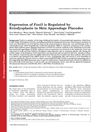Salivary Gland Function in Persons with Ectodermal Dysplasias
September 2003
in “
European journal of oral sciences
”
TLDR People with ectodermal dysplasias often have reduced saliva production and should get saliva tests.
The study aimed to understand salivary gland involvement in ectodermal dysplasias (EDs) by comparing 39 individuals with ED (median age 12 years; 24 males, 15 females) to a healthy control group. It was found that 33% of the ED group had significantly reduced secretion of submandibular and/or parotid saliva, along with low unstimulated and/or chewing-stimulated whole salivary flow. The median secretory rate of submandibular saliva was reduced in the ED group, while the median concentrations of some protein parameters were increased, though the overall protein output was normal or reduced. Submandibular glands were more affected than parotid glands in EDs. The study concluded that salivary secretory tests are recommended for individuals with known or suspected EDs.



